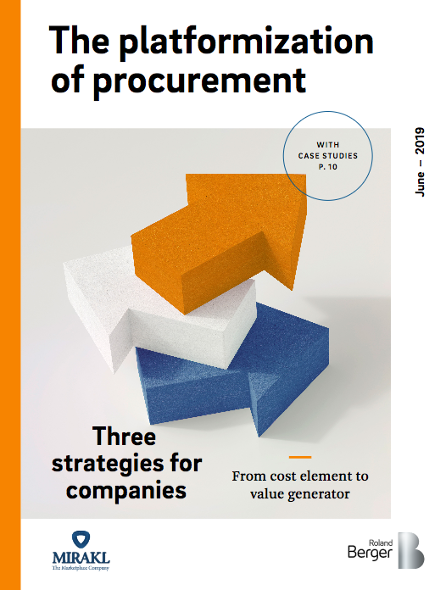Challenges and opportunities in the platformization of procurement
![{[downloads[language].preview]}](https://www.rolandberger.com/publications/publication_image/The-Platformization-of-Procurement_download_preview.png)
Procurement platforms offer several critical advantages over classic procurement channels. We identify three potential strategies for platformization.


The way in which companies create value through their business models and the configuration of their value chains is being reshaped by digital disruption, placing new demands on procurement. “The platformization of procurement,” a joint study by Roland Berger and Mirakl, explores how procurement platforms can offer substantial advantages over traditional procurement channels, and outlines three useful strategies. Choosing the right strategy – or combination of strategies – has the potential to transform procurement from a cost element to a value generator.
The first strategy is to use a generalist procurement platform for the company’s tail spend sourcing. The company selects a platform which is operated by a third party and creates a process for end users to purchase items via the platform. This strategy is suitable for standardized and low complexity products like office supplies, standard IT solutions, and cleaning products.
Generalist platforms offer many advantages. First, they keep maverick spend to a minimum and make all company spend trackable and manageable. Second, they simplify the procurement process for both the buyer within the company and the procurement function. Third, the buyer can choose from a wider range of products than in the past. Finally, procurement platforms offer competitive prices, thanks to the operation of the market mechanism.

The second strategy is to partner with a specialist platform to address additional spend categories and services. It could be that more specialized products are required, calling for a curated product portfolio with a special set of products not available on a normal platform – raw materials, packaging, IT products or specific cleaning services, for example. The platform provider needs to be more of an expert partner than a generic one-stop shop.
Companies often use Strategy 2 for their B spend in combination with Strategy 1 for their C spend to reduce the effort required when buying more complex products, enabling buyers to concentrate on more value-adding tasks. The fact that the platform specializes in particular products means that the trading volumes are bigger, resulting in greater competitiveness. Some specialist platforms also act as a quality gate, selecting only the best suppliers and products, therefore avoiding the risk of inferior products or even fraud.
The third strategy is for companies to establish their own platform by building a marketplace which they operate. The platform can either function internally or serve other firms, turning procurement into a value generator rather than just a cost element.
Owning your own procurement platform has three advantages. First, all revenues from the platform – both subscription fees from suppliers and commission on transactions – go to the company. Second, having your own platform minimizes the risk of unfavorable terms or conditions being imposed. Third, you can customize your platform to the needs of the business, adding specific features and other requirements. As more buyers and suppliers join the platform, it will grow in scale and so become more attractive.
The future of procurement platforms lies in an expanding marketplace ecosystem . More and more specialist platforms will emerge to cater to the specific needs of buyers. At the same time, procurement organizations will tap into the marketplace business and new buyers will enter as the pie grows as a whole. And we expect to see all three strategies outlined above to coexist. With this in mind, the key task for procurement departments is to find the right combination of strategies and tools that enable it to focus on core value-adding tasks and contribute to the success of the overall business.
The future of procurement platforms lies in an expanding marketplace ecosystem. More and more specialist platforms will emerge to cater to the specific needs of buyers. At the same time, procurement organizations will tap into the marketplace business and new buyers will enter as the pie grows as a whole. And we expect to see all three strategies outlined above to coexist. With this in mind, the key task for procurement departments is to find the right combination of strategies and tools that enable it to focus on core value-adding tasks and contribute to the success of the overall business.

![{[downloads[language].preview]}](https://www.rolandberger.com/publications/publication_image/The-Platformization-of-Procurement_download_preview.png)
Procurement platforms offer several critical advantages over classic procurement channels. We identify three potential strategies for platformization.